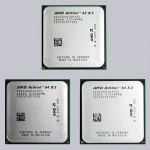
AMD Athlon64 X2 4000+ Socket AM2 CPU overclocking. Here are some AMD Athlon64 X2 4000+ Socket AM2 CPU overclocking results. AMD Athlon64 X2 4000+ Socket AM2 CPU overclocking review.
Fast processors are due to the very low prices at the top of most PC enthusiasts’ shopping lists. But which one should you buy and what CPU overclocking result can you expect? ocinside.de ordered 3 x AMD Athlon64 X2 4000+ socket AM2 CPUs and overclocked these very inexpensive CPUs. Without betraying too much – all three processors could be overclocked from original 2100 MHz (X2) up to far over 3000 MHz (X2), whereby not only the benchmark result was increased, but also the power consumption.
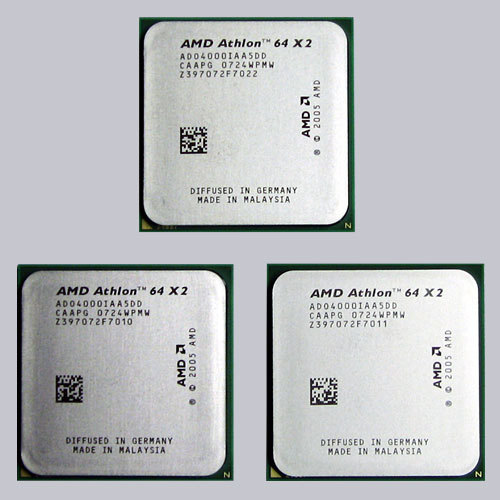
CPU type, CPU price and CPU purchase …
For this review three ADO4000IAA5DD X2 4000+ Tray processors were bought, in order to determine differences within an identical product series.
The AMD Athlon64 X2 4000+ Socket AM2 G1 Tray has currently a price of approx. 50 Euro (conditions 02/2008).
They’re available e.g. at our sponsors.
The supply of the three AMD Athlon64 X2 4000+ Socket AM2 processors …
Tray processors are delivered in this small anti-static packing. Of course they’re not as nice as the boxed packing, but it’s space-saving and more inexpensive:

That is contained in the scope of delivery …
Tray CPUs were delivered without any installation manual, so “just” the processor is contained in the package. Here’s another picture of the three AMD Athlon64X2 4000+ processors:
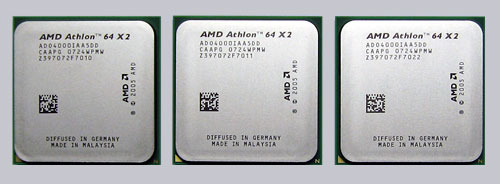
Technical data …
| Manufacturer | AMD |
| Article number (OPN) | |
| Name | Athlon 64 X2 Dual-Core 4000+ |
| Package | Socket AM2 (940 Pin Lidded OµPGA) |
| Stepping | G1 |
| Frequency | 2x 2100 MHz |
| Technology | 65nm (0,065µm) |
| Voltage | variable 1.25 – 1.35 Volt |
| Max. Temp. | variable 55-72°C |
| Thermal power | 65 Watt |
| Cache | L1 Cache: 2x 64KB L2 Cache: 2x 512KB |
Characteristics and other features …
AMD Athlon64 X2 4000+ Socket AM2 processors are delivered with a DIE (CPU core) protection, a so called heatspreader. It’s possible to remove this CPU heatspreader for better heat conduction. But of course by removing the CPU heatspreader or with overclocking you’re loosing the warranty!!!
Test Hardware and Software …
The overclocking tests were made on the Foxconn C51XEM2AA nVidia nForce 590 SLI motherboard, which offers an extensive Vcore increasement and separate NB/SB/CPU multiplicator adjustment. Reference clock increasing is necessary to overclock a CPU with locked multiplier, but it also increases the HT (hypertransport) and Northbridge/Southbridge (chipset) frequencies, as well as the memory frequency (integrated DDR2 memory controller) without a change of their divisors and/or multiplicators.
If you like to get more informations about the dependence of the PC frequencies, should take a look into our forum, where you’ll find a very extensive OC guidance in the AMD Overclocking section. Further information about overclocking can be found as always in the workshop of ocinside.de.
Furthermore a nVidia 6600 GT PCI express video card and a Crucial Ballistix tracer PC2-8500 2x 1GB memory kit in dual channel mode was used for the overclocking test. As operating system Microsoft Windows XP Professional SP2 is used. The stability was examined with the software Memtest86 and 3DMark 03 (CPU Score) as well as SiSoft Sandra Lite 2008 were used for a benchmark. CPU-Z is helpful to take a fast look at the system configuration and CPU data. All specified programs and a lot of overclocking tools can be found on our Overclocking Download page.
Benchmark values, power consumption, overclocking and test results …
AMD Athlon64 X2 4000+ Socket AM2 processors have a multiplier of 10.5x and with the original reference clock of 200 MHz they’re clocked with 2100 MHz. In our test the processors have 1.136 V default CPU voltage (Vcore). The multiplicator is like on most current AMD processors upward locked and can be thus only reduced.
Here is a screenshot of the original CPU values:
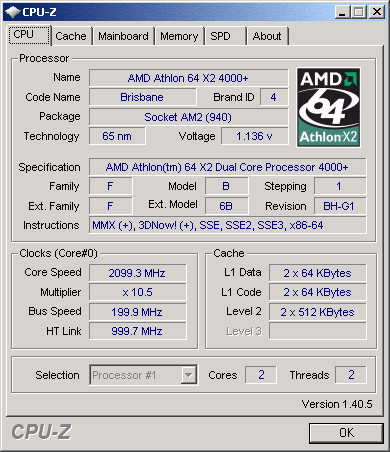
With above specified components the system got a result of 8556 3DMark 03 benchmark points (1081 CPU).
The power consumption is another important criteria particularly for users, who let the PC run 24/7. Therefore those PC power consumption values were measured as well.
The external measured power consumption was altogether 108 Watts (220 V 50 Hz) With full load the current consumption of the PC was approx. 170-182 Watts
Now it’s time to set the PCI/PCIe clocking asynchronous, set the HT divisor for SB and NB to 1x and set the memory on DDR2-400, because without these changes we would reach too high frequencies for other hardware components by increasing the reference clock. But we would like to reach as high CPU overclocking as possible at first, so we change it in the BIOS.
We change the Vcore in the BIOS to 1.30 V for our first tests. Now the reference clock is increased in several steps with a short boot test is made first in each case. After some years overclocking (yes, it was also possible to overclock an 80286 processor, however it was necessary to solder a crystal *LOL*) it’s easy to estimate the maximum values very fast. Less experienced overclocker should overlock in much smaller steps!
As soon as the CPU frequency does not run stable any longer, the Vcore is raised until the processor works perfectly with this clocking. By the way “stable” means it was tested during a longer period with e.g. stress tools like for example Prime – therefore it’s also called “prime stable”.
Here are some selected values, which represents the necessary voltage dependent to the possible frequency (Vcore steps without improvement of stability were skipped in this table):
| reference clock | mutliplier | CPU frequency | Vcore | boot | stable |
| Default: 200 MHz | 10.5 | 2100 MHz | 1.15 Volt |
 |
 |
| 260 MHz | 10.5 | 2734 MHz | 1.15 Volt |
 |
 |
| 280 MHz | 10.5 | 2931 MHz | 1.15 Volt |
 |
 |
| 290 MHz | 10.5 | 3051 MHz | 1.15 Volt |
 |
 |
| 290 MHz | 10.5 | 3051 MHz | 1.30 Volt |
 |
 |
| 300 MHz | 10.5 | 3150 MHz | 1.30 Volt |
 |
 |
| 300 MHz | 10.5 | 3150 MHz | 1.35 Volt |
 |
 |
| 300 MHz | 10.5 | 3150 MHz | 1.40 Volt |
 |
 |
| 310 MHz | 10.5 | 3246 MHz | 1.40 Volt |
 |
 |
| 310 MHz | 10.5 | 3246 MHz | 1.45 Volt |
 |
 |
| 320 MHz | 10.5 | 3360 MHz | 1.45 Volt |
 |
 |
| 320 MHz | 10.5 | 3360 MHz | 1.55 Volt |
 |
 |
As you can see, it was also possible to overclock the processor with a lower Vcore. Above approx. 3000 MHz it was necessary to raise the voltage a little bit and beyond 3150 MHz it was necessary to increase the Vcore in our tests over manufacturer’s specification. Of course the warranty already expired with the increasement of the reference clock, however the heat development with a higher Vcore increasement is so enormous that there’s no more chance to cool such an overclocked processor with a conventional air cooler. Above approx. 3150 MHz the overclocking with these processors is thus rather something for hardcore overclockers with water cooler or compressor cooler 😉
Furthermore there were little differences with the other two Athlon 64 X2 4000+ test processors, starting above approx. 310 MHz system clock or approx. 3250 MHz CPU clock. All three test CPUs ran with approx. 3250 MHz, however the Vcore had to be increased on one CPU to 1.45V, on the second CPU to 1.40 V and on the third CPU to approx. 1.50 Volt.
The test values with all three Athlon 64 X2 4000+ processors were thus on same Vcore approx. 3150 MHz.
Here is a CPU-Z screenshot with the ADO4000IAA5DD CPU on approx. 3160 MHz (instead of 2100 MHz!), with approx. 1.40 V CPU voltage (according to CPU-Z 1.384 V) and 1x HT multi:
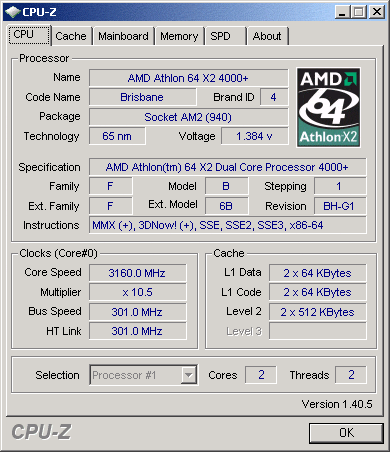
With the components specified above the 3DMark 03 benchmark result is raised from 8556 points (1081 CPU) after overclocking to 8952 points (1268 CPU) and this succeeded without optimally multiplicators for this new reference frequency.
Sure, with this high reference clock, CPU frequency and Vcore, the power consumption was increased, too.
The external measured PC current consumption was after overclocking instead of 108 W about 130 Watts (idle). With full load the power consumption of the PC was instead of 170-182 W clearly higher 230-243 Watts.
Result and general impression …
The AMD Athlon64 X2 4000+ Socket AM2 ADO4000IAA5DD processor has everything that one can expect from current processors at a favourable price: Low power consumption on low CPU load, high performance with two processor cores and an enormous high overclocking potential!
The latter is of course very interesting for customers with a small purse, because it is often very easy to improve the CPU performance within a few minutes. With all three test processors it was possible to reach 2100@3150 MHz with low Vcore values and with more increased CPU voltage they reached up to 3360 MHz. Theoretically 3360MHz has a rating above an Athlon64 X2 6400+ CPU – nice overclocking results for little money!
All in all this AMD Athlon64 X2 4000+ processor got the ocinside.de Overclocking Dream Award (02/2008). Last time, this “Overclocking Dream” award is more than 7 months ago, where the manufacturer Crucial got this coveted award for their Ballistix Tracer PC2-8500 memory modules.

Discuss in our forum and exchange experiences …
Read on in the hardware test area with several hardware reviews …

